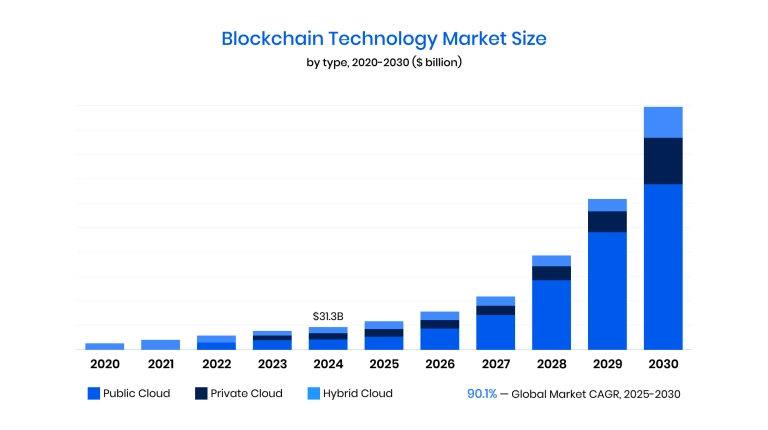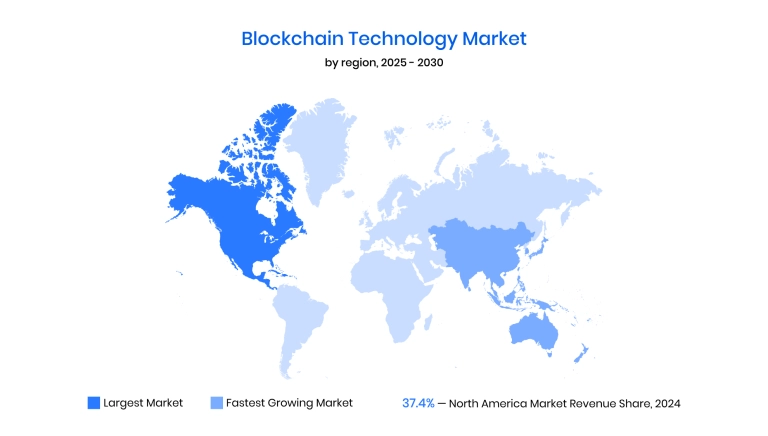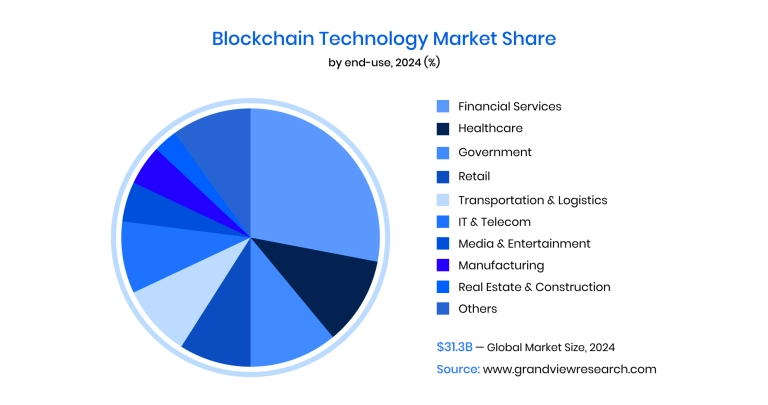Blockchain trends are no longer confined to buzzwords and speculation. They're shaping real products, guiding policy shifts, and defining how businesses build trust in digital systems. As we move toward 2030, blockchain is maturing and it's no longer just about cryptocurrency.
From decentralized identity and smart contract automation to enterprise-grade infrastructure, blockchain is entering a new phase. In this article, we'll break down the practical shifts worth watching – not the hype but the tools, models, and platforms that are changing how real-world systems are built.
Here's what you'll learn:
- Which blockchain trends will matter most through 2030 – and why they're different from the last hype cycle.
- How companies are leveraging blockchain for more than just currency, from supply chains to identity management.
- What technical changes (Layer 2s, zk-proofs, etc.) mean for developers and businesses.
- What's driving adoption in regulated industries and how it's shaping security and compliance
Let's unpack what's coming and what actually matters for blockchain development in the next five years.
Embrace blockchain technology for enhanced growth, security, and efficiency
Growth of the blockchain technology market
The market is growing steadily in line with blockchain development trends, not in viral bursts but through consistent investment and adoption across various sectors. Its momentum is no longer tied to crypto cycles. Instead, it’s becoming foundational for industries like finance, logistics, healthcare, and energy.
The global blockchain technology market was valued at .57 billion in 2023 and is projected to grow at a compound annual growth rate (CAGR) of 87.7% from 2024 to 2030. The report highlights the growing demand from enterprises and the rise of blockchain-as-a-service (BaaS) platforms as major drivers of this acceleration.

Complementing this, Market.us estimates that the market could reach ,231.6 billion by 2032, reflecting broader adoption across both developed and emerging markets.
As the report notes: "The increasing demand for secure and transparent transactions is one of the major factors driving the market."
The global blockchain technology market is experiencing rapid growth, with regional trends influencing adoption. In the US, the development of blockchain is driven by regulatory progress, government interest in digital identity and supply chains and strong VC-backed innovation. Asia Pacific is the fastest-growing region, with countries such as China, Japan, India, and South Korea promoting blockchain in trade, finance and public services.
This reflects a broader shift in the future of blockchain technology, where national strategies and infrastructure support the real-world integration of blockchain. In Europe, clear regulations (for example, MiCA), cross-border collaboration, and sustainability goals are shaping the adoption of blockchain, with its use expanding in energy and carbon tracking. The UK and Germany are leading examples of how blockchain technology trends are moving from experimentation to enterprise-grade solutions across fintech and industry.

The shift is evident – the best blockchain development trends are evolving from niche innovation into core digital infrastructure. This trajectory sets the stage for long-term applications that extend far beyond the cryptocurrency realm.
5 best blockchain development trends for 2026
The future of blockchain is unfolding in quiet but fundamental ways. No longer driven by hype cycles, blockchain is now solving real infrastructure problems, from scalability and compliance to data integrity and identity management. What matters today isn't just what blockchains can do but where they're already gaining adoption, reshaping industries from the backend out.
Let's explore five core trends in blockchain that are driving development in 2026, backed by live deployments, enterprise investment, and a long-term vision.
1. Modular blockchain architectures
Modular blockchains decouple core functions, such as consensus, execution, and data availability. This architecture addresses the scalability limitations of monolithic chains, enabling teams to create customizable and efficient networks tailored to specific use cases.
Key developments:
- Celestia launched its mainnet in late 2023, becoming the first modular data availability network.
- Polygon 2.0 introduced a restructured modular framework, integrating ZK tech and multichain coordination.
- EigenLayer enables re-staking of ETH to secure various modular services, creating a shared security layer.
This architecture supports faster iteration and network specialization – a major blockchain trend for developers building scalable, composable ecosystems.
Modular blockchains enable startups to launch their execution layers without building full L1s (base-level blockchains). For example, rollups can utilize Celestia for data availability and customize their environment to optimize speed, privacy, or compliance, drastically reducing infrastructure costs and time-to-market.
2. Zero-knowledge proofs (ZKPs) at scale
ZKPs enable one party to prove information without revealing the data itself. In practice, this boosts privacy and allows for faster, lighter transactions, particularly on Layer 2 networks and privacy-critical systems.
Key developments:
- zkSync Era and Starknet are processing real volume with ZK rollups on Ethereum.
- Polygon zkEVM launched in mainnet-beta, offering EVM compatibility with ZK proofs.
- Visa tested ZK-based auto-payments, enabling recurring transfers on Ethereum without exposing private data.
ZKPs are enabling privacy, efficiency, and regulatory compliance at scale – a powerful trend driving adoption across payments, ID systems, and DeFi.
Governments can use ZKPs to facilitate secure, anonymous online voting, ensuring that each vote is counted without revealing voter identity. Estonia piloted such a system using ZKP-based mechanisms, allowing citizens to vote remotely while maintaining full verifiability and privacy.
3. Real-world asset (RWA) tokenization
Tokenization converts physical or financial assets, such as bonds, real estate, or commodities, into blockchain-based tokens. It enhances liquidity, improves transparency, and enables fractional ownership.
Key developments:
- BlackRock’s BUIDL Fund raised $240M+ on Ethereum by tokenizing US treasuries.
- HSBC launched tokenized gold trading via blockchain for 24/7 real-time settlement.
- Hong Kong issued tokenized green bonds using blockchain for enhanced transparency.
RWAs connect blockchain with traditional markets, providing digital rails for trillions in value. This is one of the most tangible trends in blockchain heading into 2030.
SunContract enables peer-to-peer electricity trading by connecting energy producers directly with consumers on a blockchain-based platform. Through its energy pool, registered users can buy and sell electricity using SunContract tokens (SNC), bypassing traditional utility intermediaries.
4. Blockchain for digital identity and compliance
Governments and enterprises are investing in blockchain-based ID systems to streamline verification, reduce fraud, and meet growing regulatory demands. These decentralized IDs (DIDs) give users control over personal data while enabling secure compliance.
Key developments:
- The EU's EBSI program supports eID and academic credential verification across member states.
- Worldcoin launched its proof-of-personhood protocol, which utilizes biometric registration and on-chain identity.
- Polygon ID offers self-sovereign identity infrastructure, using ZKPs for private credentials.
Digital ID is foundational for real-world adoption, from Know Your Customer (KYC) in fintech to public records in e-government. Blockchain gives it the security and interoperability needed at scale.
EBSI is being piloted in cross-border credential systems across the EU, letting students and citizens verify documents digitally via blockchain.
5. Blockchain as infrastructure for AI
As AI becomes more powerful, questions of data sourcing, model transparency, and compute ownership are rising. Blockchain can anchor trust — by tracking data provenance, decentralizing compute, and verifying agent behavior.
Key developments:
- Ocean Protocol allows secure, decentralized data sharing and monetization for AI training.
- Bittensor (TAO) built a blockchain network where AI models collaborate and compete for tokens.
- Fetch.ai combines autonomous AI agents with on-chain coordination tools for real-world automation.
This emerging blockchain trend addresses one of AI's biggest gaps: trust in data and processes. It enables open, accountable AI systems outside corporate silos.
SingularityNET and Fetch.ai provide decentralized infrastructure for AI development. SingularityNET hosts an open marketplace for AI tools, while Fetch.ai enables autonomous agents to exchange data and services using blockchain for coordination, usage tracking, and payments.
Blockchain technology trends across industries
The role of blockchain is expanding across sectors, driven by real use cases and growing institutional trust. As we move into 2026, blockchain technology updates reflect a shift from theory to practical adoption, with industries such as finance, healthcare, and supply chain leading the charge.
In 2024, financial services led blockchain adoption, with the technology streamlining transactions, reducing costs, and supporting use cases like ICOs and digital assets – all key blockchain developments in the BFSI sector.

Meanwhile, healthcare is expected to grow at the fastest rate through 2030, driven by global data protection laws like GDPR and a post-COVID push for digitalization. These blockchain technology advancements are helping secure patient data and improve transparency across medical systems.
Financial services
Financial services like blockchain in banking remain the largest contributor (40% ) to global blockchain market revenue in 2024. This dominance highlights that blockchain is still relevant in banking and finance – not just for crypto assets, but also for streamlining cross-border payments, clearing, settlement, and digital identity management.
A major development in finance is the rise of stablecoins, such as USDC, which are pegged to fiat currencies and offer fast, transparent, and low-cost payments for remittances, trading, and online commerce. In parallel, Central Bank Digital Currencies (CBDCs) are gaining global momentum. Projects like China’s Digital Yuan and the EU’s Digital Euro pilot reflect how governments are exploring blockchain-based alternatives to physical cash, combining regulatory oversight with digital efficiency.
Healthcare
The blockchain in healthcare sector is enhancing data security, interoperability, and supply chain transparency. According to Grand View Research, the global blockchain in the healthcare market was valued at .04 billion in 2023 and is projected to reach $11.33 billion in 2024, growing at a CAGR of 63.3% from 2024 to 2030.
Blockchain's decentralized and immutable ledger ensures data integrity and reduces the risk of data breaches, which is crucial for handling sensitive patient information. It facilitates secure sharing of Electronic Health Records (EHRs), streamlines billing and claims processing, and enhances supply chain management for pharmaceuticals and medical devices.
Media and entertainment
The media and entertainment sector is rapidly adopting blockchain to enhance transparency, combat piracy, and ensure fair compensation for creators. In 2024, the market was valued at .5 billion and is projected to reach $20.5 billion by 2033, growing at a CAGR of 18.5%.
The need for secure content distribution and rights management drives this growth. Platforms like MoviePass are exploring blockchain-based systems to gamify movie experiences and engage audiences in new ways.
For businesses looking to innovate in this space, understanding how to create a blockchain tailored to media applications is the key.
Retail
Retailers are leveraging blockchain to enhance supply chain transparency, prevent fraud, and improve customer trust. The global blockchain in the retail market reached 5.4 million in 2024 and is expected to grow at a CAGR of 41.3% from 2025 to 2033.
Luxury brands like Gucci and Balenciaga have begun accepting cryptocurrency payments, highlighting how emerging blockchain trends are transforming consumer expectations and payment systems.
Partnering with a blockchain development company can help retailers effectively implement these technologies.
Education
Blockchain is transforming education by securing academic records, verifying credentials, and facilitating lifelong learning. The global blockchain in education market was valued at $0.35 billion.35 billion in 2024 and is projected to reach $9.39 billion by 2033, growing at a CAGR of 43.94%.
As institutions seek to modernize, new blockchain technology provides a secure and tamper-proof method for managing certifications, automating verification, and reducing administrative overload. For instance, Binariks developed a blockchain-based education platform that enables secure and transparent management of academic credentials.
Adoption challenges
Blockchain adoption is accelerating, but the path to implementation is rarely straightforward. Understanding the barriers and how to address them is essential for delivering meaningful results. Below are the most common challenges organizations face, along with proven ways to navigate them:
- Integration with legacy systems
Many enterprises rely on outdated infrastructure that isn't designed for decentralized logic or data structures. A phased approach works best – starting with standalone blockchain modules (e.g., audit trails, product traceability) that connect to existing systems via APIs without requiring full overhauls.
- Limited in-house expertise
Skilled blockchain engineers, architects, and compliance analysts are still in short supply. Instead of building everything from scratch, companies benefit from partnerships with experienced vendors and the use of pre-validated components and frameworks that reduce development risks.
- Long deployment timelines
Transitioning from pilot to production can often take longer than expected. This can be mitigated by focusing on use cases with immediate operational impact, such as KYC automation or asset tracking, and applying agile delivery models to release value incrementally.
- Regulatory uncertainty
In highly regulated industries, the lack of clear legal frameworks around smart contracts, tokenization, or data storage can delay decision-making. Addressing this requires aligning early with standards like MiCA, HIPAA, or GDPR and selecting blockchain architectures that support auditability and privacy controls (e.g., ZKPs).
- Unrealistic ROI expectations
Some stakeholders anticipate fast, high returns from blockchain investments. Instead, success depends on clear ROI models, defined metrics, and a focus on efficiency gains, transparency, or compliance – not just hype-driven innovation.
Adoption challenges are real, but they are rarely insurmountable. With the proper structure,
realistic planning, and focused use cases, blockchain can transition from concept to business-critical infrastructure – without disrupting everything at once.
What's next?
According to Roomy Khan , an analyst and public speaker on ethics and compliance issues, "Traditional finance isn't just adopting crypto – it's being rebuilt around it," signaling a paradigm shift toward institutional-grade infrastructure. This reflects a major future trend in the blockchain technology movement, as banks integrate blockchain directly into payment systems, custody services, and market operations. This will make decentralized ledgers a core part of their architecture.
"With over 60 crypto platforms now working with Visa, the company is unlocking new use cases beyond trading, including remittances and cross-border payments. This transformation extends beyond payments".
Meanwhile, CryptoRank highlights a surge in automated systems, reporting that "AI agents lead crypto narratives with 67% gains in 30‑day market performance". Despite occasional market downturns, AI‑driven crypto agents are emerging as a powerful force in decentralized finance and smart contract automation, marking a key milestone in blockchain technology development toward autonomous, intelligent systems.
Final thoughts
As blockchain adoption extends beyond cryptocurrency, future trends in blockchain technology are increasingly shaped by real-world demand for trust, transparency, and automation.
From financial education services, blockchain is evolving into a foundational layer across industries. Companies that recognize the rapid blockchain technology development and take action early are better equipped to minimize friction, reduce costs, and create more resilient digital systems.
At Binariks, we help businesses stay ahead of the curve by delivering end-to-end blockchain consulting, development, and implementation. Our expertise spans smart contracts, decentralized apps, asset tokenization, and interoperability solutions tailored to meet your unique industry needs.
Whether you want to streamline claims in insurance, secure patient records in healthcare, or power next-gen fintech products, Binariks is your trusted partner in unlocking the full value of blockchain technology.
FAQ
Share
